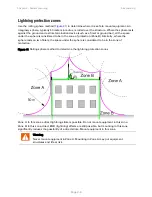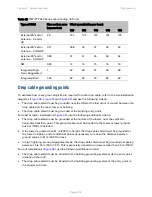
Chapter 3: System planning
Radio Frequency planning
Page 3-18
Obstructions in the Fresnel Zone
The Fresnel (pronounced fre·NEL) Zone is a three-dimensional volume around the line of sight of
an antenna transmission. Objects that penetrate this area can cause the received strength of the
transmitted signal to fade. Out-of-phase reflections and absorption of the signal result in signal
cancellation.
The foliage of trees and plants in the Fresnel Zone can cause signal loss. Seasonal density,
moisture content of the foliage, and other factors such as wind may change the amount of loss.
Plan to perform frequent and regular link tests if you must transmit through foliage.
Planning for co-location
The first step to avoid interference in wireless systems is to set all AP/BHMs to receive timing from
a synchronization source (Cluster Management Module, or Universal Global Positioning System).
This ensures that the modules are in sync and start transmitting at the same time each frame.
The second step to avoid interference is to configure parameters on all AP/BHMs of the same
frequency band in proximity such that they have compatible transmit/receive ratios (all stop
transmitting each frame before any start receiving). This avoids the problem of one AP/BHM
attempting to receive the signal from a distant SM/BHS while a nearby AP/BHM transmits, which
could overpower that signal.
Note
Refer to Frame Alignment Legacy Mode parameter of Configuration > Radio >
Adavance tab for legacy product settings (See
Table 132 PMP 450i AP Radio attributes
- 5 GHz
on page
7-128)
.
The following parameters on the AP/BHM determine the transmit/receive ratio:
Downlink Data percentage
Frame Period
Max Range
(reserved) Contention slots
If OFDM (450 Platform Family, PMP/PTP 230) and FSK (PMP/PTP 1x0) APs/BHMs of the same
frequency band are in proximity, or if you want BHMs set to different parameters then you must
use the Frame Calculator to identify compatible settings for APs/BHMs.
The co-location is also supported for 900 MHz PMP 450i Series APs (OFDM) and PMP 100 Series
APs (FSK).
The Frame Calculator is available on the web management interface Tools > Frame Calculator. To
use the Frame Calculator, type into the calculator various configurable parameter values for each
proximal AP/BHM and then record the resulting AP/BHM Receive Start value. Next vary the
Downlink Data percentage in each calculation and iterate until a calculated AP/BHM Receive Start
for all co-located AP/BHMs where the transmit end does not come before the receive start.
Summary of Contents for PMP 450 Series
Page 125: ...Chapter 3 System planning Typical deployment Page 3 3 Figure 37 Wall installation...
Page 126: ...Chapter 3 System planning Typical deployment Page 3 4 Figure 38 Roof installation...
Page 127: ...Chapter 3 System planning Typical deployment Page 3 5 Figure 39 GPS receiver wall installation...
















































